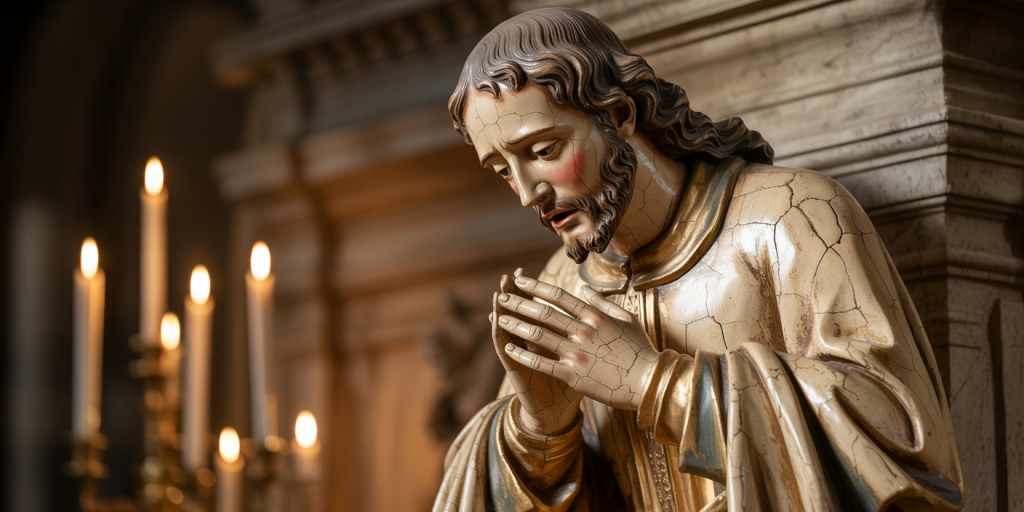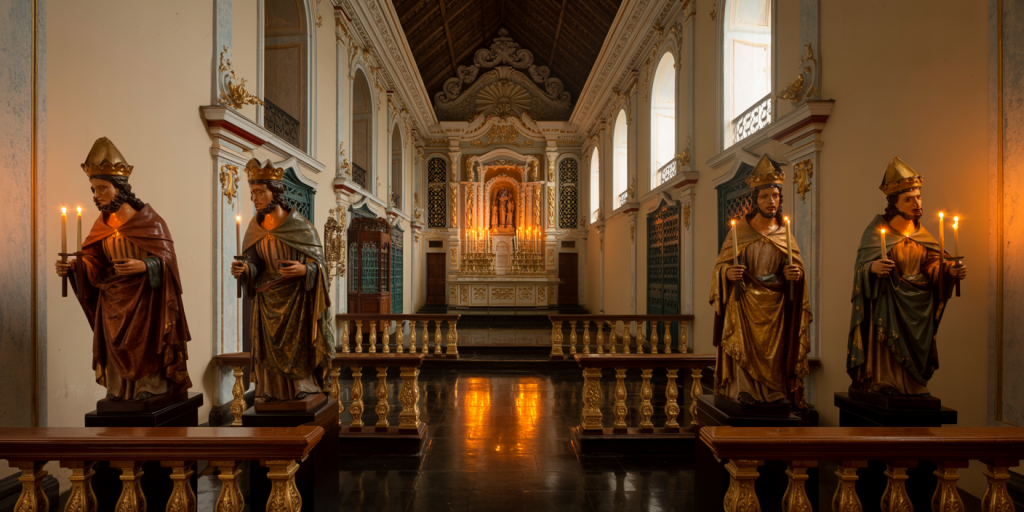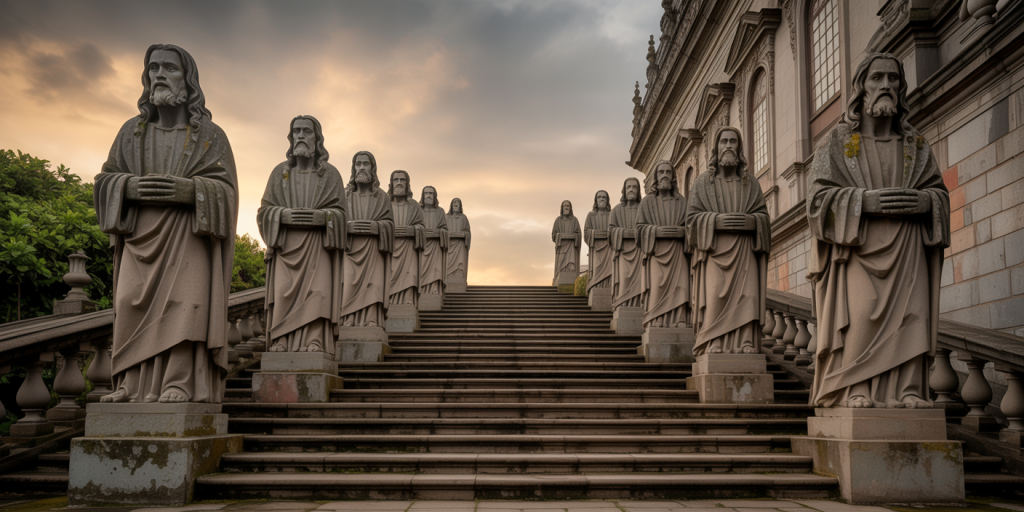From Clay to Being: Aleijadinho and the Mysticism of Wounded Form
In the stillness of Minas Gerais, where hills roll like ancient hymns and stone churches rise from the earth like prayers cast in granite, a sculptor listened to silence and carved its pain into permanence. His hands, deformed by illness but guided by something deeper than flesh, transformed clay and soapstone into vessels of ecstasy and suffering. Antônio Francisco Lisboa, known as Aleijadinho, did not merely sculpt saints—he gave contour to agony, he gave flesh to transcendence. His chisel did not wound the stone; it liberated its sorrow.
His sculptures do not whisper; they lament. They bleed in posture, in gaze, in drapery torn by inner fire. One does not merely view his work; one enters a sacred wound, a site where divinity and decay meet in raw embrace. It is not baroque alone, nor colonial. It is mystical realism carved with fever. It is Brazil dreaming in stone.
Table of Contents
- Flesh Born of Dust
- Hands That Spoke Through Hurt
- The Crown and the Earth
- Baroque in Ecstasy
- The Stone That Weeps
- Gestures Suspended in Prayer
- The Echo in the Eyes
- Ornament as Redemption
- Chisel as Psalm
- The Chapel of Silence
- Faces from the Depth of Belief
- Texture of the Spirit
- Blood Carved in Rhythm
- Sacred Asymmetry
- Light on a Broken Shoulder
- Devotion as Architecture
- The Steps of the Prophets
- From Ouro Preto, the Lament Rises
- The Sculptor Who Became His Saints
- The Faith Between Fingers
Flesh Born of Dust
Aleijadinho’s figures seem as if they never left the earth—as though they rose directly from the soil, infused with memory. His medium, soapstone and cedar, carries the scent of rain and ruin. The very grain of the material absorbs the mood of the mountains.
This is flesh born of dust, molded by someone who knew intimately the fragility of the body. There is a humility in the surface, a porousness that breathes.
Hands That Spoke Through Hurt
Stricken by disease, Aleijadinho lost the use of his limbs. But he continued to sculpt, strapping tools to his arms. The body that failed him birthed bodies divine. Pain was not an obstacle but an offering.
Each hand carved is a prayer. Fingers curled in supplication, not frozen in death but alive with spiritual ache. His own suffering gave shape to a universal lament.

The Crown and the Earth
The crowns Aleijadinho sculpted were heavy with symbolism. They did not elevate the saints but burdened them. Each one a circle of pain, anchoring the figure to earthly weight.
The dialogue between heaven and soil is constant. His saints are not ethereal; they lean, they stagger. Divinity, here, is something hard-earned.
Baroque in Ecstasy
Aleijadinho belongs to the Baroque, but he stretches its boundaries. He strips it of flourish and clothes it in wound. Movement surges in his compositions, but it is not dance. It is convulsion, rapture, seizure.
Draperies twist like spirits in torment. Muscles strain under robes of grace. This is not mere drama. It is sacred crisis.
The Stone That Weeps
Some sculptures seem to cry, not through tears but through texture. The stone is carved with such sensitivity that it feels wet, swollen with grief. The grooves along the cheeks, the downturned lips, the furrows of brow—they pulse with mourning.
Aleijadinho did not need realism to invoke empathy. He used distortion like a poet uses metaphor.
Gestures Suspended in Prayer
His figures often hold gestures mid-air: a hand half-raised, a finger pointing to an unseen horizon. These are not completed movements. They are hesitations, breaths held between pain and praise.
This suspension lends a liturgical tempo to the work. It invites the viewer not just to see, but to pause.
The Echo in the Eyes
The eyes of Aleijadinho’s saints do not meet ours. They look beyond, inward, upward. Their pupils are windows to storms.
Painted or hollowed, these eyes are wells of silence. We peer into them and hear echoes: of prayer, of pleading, of absolution yet to come.
Ornament as Redemption
Detail in Aleijadinho’s work is not excess. It is salvation. The ornate cuffs, the embroidery carved into stone, the gold-leaf remnants—each is a shield against despair.
He did not ornament to impress, but to soothe. In the delicate curves of a collar, one sees a balm for pain.
Chisel as Psalm
His chisel was more than a tool. It was a psalmist. It recited verses not in words, but in form.
Every stroke was rhythm, every notch a syllable of devotion. The surface of his sculpture reads like sacred poetry.
The Chapel of Silence
Many of his works are placed in small chapels—spaces of hush. The architecture around his figures deepens their solemnity.
Within such stillness, even breath feels profane. One does not talk before his work. One listens.

Faces from the Depth of Belief
Each face he sculpted carries not beauty, but depth. Wrinkled brows, sunken cheeks, open mouths—these are not idealized forms. They are devout, worn, enduring.
These faces know something. Of poverty, of sickness, of faith tested by fire. They look as if they have just spoken or are about to.
Texture of the Spirit
Touch is crucial in his sculptures. Roughness is not a flaw. It is a choice.
The grain of wood, the chisel marks in soapstone—these textures speak of the invisible. Spirit is tactile in his hands. Divinity is raw.
Blood Carved in Rhythm
There is violence in his Passion figures. But it is not grotesque. It is choreographed. The wounds are rhythmic, the blood lines almost musical.
This is not brutality. It is sacred suffering rendered with grace. Pain becomes part of liturgy.
Sacred Asymmetry
Nothing is perfectly symmetrical in his saints. A shoulder drops lower, a hip turns. These irregularities are the pulse of life.
Perfection, Aleijadinho knew, is cold. His imperfection is warmth, story, humility. The divine limps, weeps, and survives.
Light on a Broken Shoulder
His sculptures catch light in strange ways. The folds of robes, the hollow of cheeks, the slope of broken shoulders—all trap and release light in rhythm.
This play of illumination makes the figures seem alive. Not theatrical, but momentary. As if caught in a beam of grace.
Devotion as Architecture
He did not only sculpt figures; he carved facades, church fronts, altars. His vision extended beyond the human form into the very spaces where faith dwells.
The Sanctuary of Bom Jesus de Matosinhos, with its twelve prophets, is not just religious art. It is a geography of belief.
The Steps of the Prophets
The prophets at Congonhas do Campo stand as sentinels on a stairway to devotion. Each bears their burden in stone. Their stances are distinct—some fierce, others weary.
They are not a procession, but a dialogue. Their presence is thunderous, even in silence.

From Ouro Preto, the Lament Rises
Aleijadinho was born in Ouro Preto, the dark gold of its name echoing the contrast in his art. Splendor and sorrow. Radiance and rust.
His sculptures carry the melancholia of this landscape. The gold rush long faded, but its ghosts remain, carved into altarpieces and pulpits.
The Sculptor Who Became His Saints
In his suffering, in his solitude, Aleijadinho blurred into his creations. He became the saints he carved. Their wounds were his. Their silence, his own.
His legacy is not just in museums or churches, but in the aching breath between faith and form.
The Faith Between Fingers
Every saint, every martyr, every prophet he sculpted holds something: a staff, a scroll, a bleeding heart. But it is the hand that truly holds the faith.
These fingers, so tenderly formed, tremble with meaning. They remind us that belief is not shouted. It is held.
FAQ
Who was Aleijadinho?
Antônio Francisco Lisboa, called Aleijadinho (“The Little Cripple”), was a Brazilian sculptor, architect, and carver born in the 18th century. Despite suffering from a debilitating illness, he created some of the most iconic religious art in Brazil.
What style did he work in?
His work is rooted in the Baroque tradition, but often departs from European influence through rawness, emotional intensity, and spiritual immediacy.
What materials did he use?
He worked primarily in soapstone and wood, often painting or gilding the figures to increase expressive contrast.
What is his most famous work?
The Twelve Prophets at Bom Jesus de Matosinhos in Congonhas, along with the Stations of the Cross at the same site, are considered his masterpieces.
How did his illness affect his art?
His illness deformed his body, but deepened his vision. He continued to create with the help of assistants, turning suffering into sacred beauty.
Closing the Wound, Opening the Soul
Aleijadinho did not heal his wounds. He revealed them. He etched them into stone so they might speak where mouths could not. His art is not triumph over suffering, but communion through it.
From clay to being, from wound to wonder, his forms endure—not as relics, but as living cries. They are hands extended in darkness, hearts carved into matter. They do not ask to be admired. They ask to be felt.
